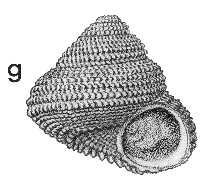
Revised descriptions of New Zealand Cenozoic Mollusca from Beu and Maxwell (1990)

 | Revised descriptions of New Zealand Cenozoic Mollusca from Beu and Maxwell (1990) | 
|
  (Pl. 19g): GS9685, J41/f9499B, Pukeuri road-cutting, Oamaru, Altonian (GNS) |
Beu & Maxwell (1990): Chapter 11; p. 188; pl. 19 g.
Synonymy: Zetela awamoana Laws 1939a, p. 477; Solariella (Zetela) awamoana
Classification: Solariellidae
Description: Small for family (height 4.5 mm), turbiniform, spire 0.6 total height. Protoconch smooth, of 1 whorl, terminated by a low, thin varix. Teleoconch whorls 3.5-4, obtusely angled adapically on early whorls, angulation gradually descending during growth and becoming obsolete on later whorls of most specimens. Last whorl with peribasal angulation; base gently convex with a broad, conical umbilicus. Axial sculpture commencing as narrow, well spaced costae reaching from suture to suture, becoming more numerous, thinner and more closely spaced, so that on later whorls it consists of imbricate lamellae forming small scales on spiral cords and subdued in interspaces; last whorl with about 75 such lamellae that persist across base and into umbilicus. Spiral sculpture commencing as 3 narrow, low cords—the uppermost on shoulder angulation—joined during growth by 2 or 3 other cords, tending to become subequal on last whorl; last whorl with additional cord of similar strength on peribasal angulation, and 6 or 7 narrow scaly cords between it and a heavy, more coarsely nodulose circumumbilical cord. Umbilicus with about 10 moderately strong, beaded cords within. Aperture subcircular, prosocline.
Comparison: Zetela awamoana is very similar to the Recent Z. textilis (Murdoch and Suter, 1906) but has more prominent spiral sculpture, particularly on the base. Z. praetextilis (Duntroonian, Castle Hill Basin) has much weaker sculpture than either Z. textilis or Z. awamoana — in particular, the axial sculpture on the last whorl consists of little more than fine nodules on the spiral cords. Z. textilis is confined to the outer shelf and uppermost slope, in 129-380 m (Marshall 1999, p. 35), and Z. awamoana probably had a similar habitat. In an overview of trochoidean and turbinoidean classification based on molecular phylogeny, Williams et al. (2008) recognised the former subfamily Solariellinae as a full family, Solariellidae.
Distribution: Altonian; Mount Harris Formation, Pukeuri (type) (moderately common); Awamoa Creek (uncommon).
Cite this publication as: "A.G. Beu and J.I. Raine (2009). Revised
descriptions of New Zealand Cenozoic Mollusca from Beu and Maxwell (1990). GNS
Science miscellaneous series no. 27."
© GNS Science, 2009
ISBN
978-0-478-19705-1
ISSN 1177-2441
(Included with a PDF facsimile file
copy of New Zealand Geological Survey Paleontological Bulletin 58 in CD version
from: Publications Officer, GNS Science, P.O. Box 30368 Lower Hutt, New
Zealand)